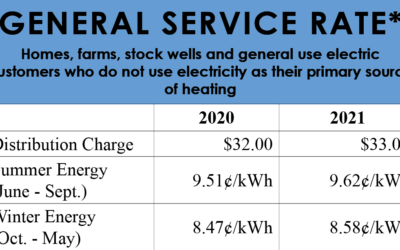
As a not-for-profit utility, Dawson PPD focuses on cost-effectively extending the life of its existing facilities while maintaining adequate levels of safety and reliability. Testing wooden poles helps the District ensure reliability and long life of its equipment, saving customers money in the long run.
Traditionally, pole testing involved a hammer for sounding, a shovel for digging around the base and drilling holes to test for decay. Today, Dawson PPD hires a contractor that uses a scientifically-based system called POLUX as a less-invasive and more accurate form of testing.
POLUX works by sending two, three inch long probes the size of an eight-penny nail into the base of the utility pole. This is the most vulnerable point where decay is most likely to occur on a pole. The probes measure resistance and moisture content of the pole. This information, along with the type of wood the pole is made of and how it was treated are run through a computer program with the pole’s GPS location recorded.
Typically, Dawson PPD uses a Southern Yellow Pine tree for its poles, which should have a resistance of 8,000 pounds per square inch when new. If the measurement falls below 50 percent of the recommended resistance, in this case 4,000 PSI, the pole is marked for replacement.
All of Dawson PPD’s poles are tested every 10 years on a rotating schedule with 10,000-11,000 poles tested annually.
OTHER NEWS
BETWEEN THE LINES: What does reliability cost?
April 2021 By Gwen Kautz Dawson PPD General Manager gkautz (at) dawsonpower.com 308-324-2386 What does reliability cost? It’s never big things that break us – it’s always the little things. My adoption of “it’s always the little things” stems from scripture in which...
Honey hobbyist connects learners with nature
April 2021 “I’ve always had an appreciation and respect for nature,” said Amy Hill, Central Community College Regional Director at the Lexington Center. Her appreciation for and awareness of bees was heightened when her son was involved in an Entomology project...
Rate increase to take effect with May billing
Dawson Public Power District rates will increase this spring. Overall, the increase will be 1.85%. The percentage varies by rate class. Residential customers will see a 1.75% increase in their electric rates. This includes a $1 increase to the distribution charge and...



